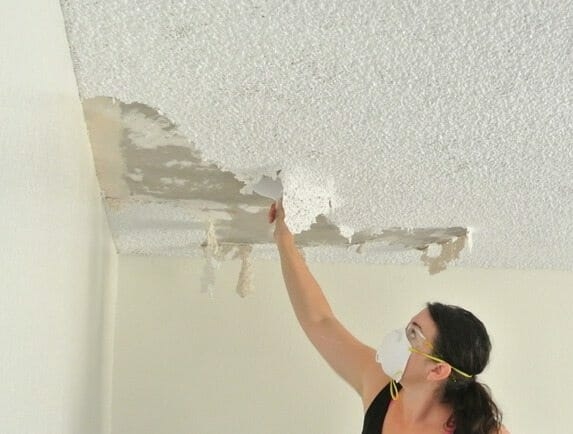Popcorn ceilings, also known as acoustic ceilings or textured ceilings, were once a popular interior design choice due to their unique appearance. However, as time has passed, concerns have emerged regarding the potential presence of asbestos in these ceilings. In this article, we will explore the question that’s on the minds of many homeowners: “Does popcorn ceilings have asbestos in it?” We’ll delve into the history of damage ceilings, the risk of asbestos, and how to address this issue.

The Popularity of Popcorn Ceilings
Popcorn ceilings became widely popular in the mid-20th century, and many homes built between the 1950s and 1980s feature this distinctive textured finish. The texture was primarily used for its acoustic properties, as it helped reduce sound reflection and echoes in rooms. Additionally, it was a cost-effective way to hide imperfections in ceiling surfaces.
The Asbestos Concern
During the same time period, asbestos was commonly used in various building materials, including popcorn ceiling textures. Asbestos was valued for its fire-resistant properties and strength. Unfortunately, asbestos is a hazardous material that, when disturbed, can release tiny, inhalable fibers into the air. These fibers are known to cause serious health problems, such as lung cancer, mesothelioma, and asbestosis.
Does Popcorn Ceilings Contain Asbestos?
Not all popcorn ceilings contain asbestos, but many do, particularly those built before the late 1970s. Asbestos was commonly added to the texture mix to enhance its fire resistance and durability. However, as awareness of asbestos-related health risks grew, the use of asbestos in construction materials, including popcorn ceilings, was phased out.
To determine if your damage ceilings contain asbestos, you can:
- Professional Testing: The most reliable method is to have a sample of the ceiling texture tested by a professional asbestos testing service. They will take a sample and analyze it for asbestos content.
- Age of the Building: As a general rule, homes built before the late 1970s are more likely to have asbestos-containing popcorn ceilings. If your home falls into this category, it’s essential to have the material tested.
- Visual Inspection: While not definitive, you can perform a visual inspection of your ceilings. If you see small, white, or gray specks in the texture, it could be an indication of asbestos.
Addressing Asbestos in Popcorn Ceilings
If your popcorn ceilings are found to contain asbestos, it’s crucial to take action to minimize health risks. Asbestos is safe when intact, but during renovation or removal, follow safety protocols.
- Professional Abatement: Asbestos-containing popcorn ceilings should be removed by professionals trained in asbestos abatement. They will take the necessary precautions to minimize asbestos exposure during the removal process.
- Sealing and Encapsulation: In some cases, rather than removing the asbestos-containing texture, it can be sealed or encapsulated. This involves applying a sealant or a new layer of drywall over the existing ceiling to prevent asbestos fibers from becoming airborne.
- Regular Inspections: If you choose not to remove or encapsulate the ceiling, you should conduct regular inspections to ensure that the ceiling texture remains intact. If any damage occurs, consult a professional immediately.
Conclusion
The presence of asbestos in popcorn ceilings is a valid concern, especially in older homes. To address the question, “Does popcorn ceilings have asbestos in it?” the best course of action is to have the material tested by professionals. If asbestos is detected, it should be managed or removed following safety protocols to protect the health of occupants. This damage doesn’t mean immediate danger, but it does need responsible management for home and occupant safety.